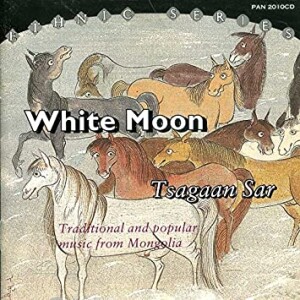 Big Earl Sellar wrote this review.
Big Earl Sellar wrote this review.
Often the term “world music” has been corrupted to encompass a small and narrow band of culturally “acceptable” music. A typical fan of this genre will have a fair-sized collection of Afro-pop, Latino popular music, a token Indian reissue and a couple of reggae albums. Which is a shame, for the world is filled with many varied surprises, if a listener is willing to experiment with the unconventional.
Mongolia is hardly a hot bed in the world music scene. Indeed, the myriad styles of Asian music are usually ignored. But the Mongolian music tradition seems more Occidental in origin than would normally be thought. It’s definitely Asiatic, but often the backing music is based on the same pentatonic scales and familiar chord progressions of European music. And many of the instruments are used to similar effect, diminishing the cultural gap normally associated with the music of uncommon cultures while still being just “odd” enough to be interesting.
Not really a band per se, Tsagaan Sar is more a collection of independent Mongolian musicians, nominally named “Melodies of the Steppes,” keeping alive ancient musical traditions. Recorded in the Netherlands, this collection brings together ancient songs about love, faith – and horses, the raising and selling of which are the basis of the Mongolian economy.
“Altain Magtaal” would not sound out of place on a collection of medieval European court songs. The bowed and plucked instruments of the steppes resemble older cantors in form, while the singing, which includes sectional lead vocalists and a throat singer, has melodies evocative of Russian or Eastern European folk styles. The haunting limbe (flute) pieces often nod toward Japanese religious music, but also suggest melodies of Breton. “Morini Yavdal” sounds like a lost hurdy-gurdy piece interspersed with sounds suggestive of horse whinnies and galloping.
Indeed, much of this music has a slightly Celtic flavour. And much of it also suggests the sounds of nature. “Urixian Xongor Salxi,” a solo limbe piece, is often evocative of both the wind, the flight of birds and butterflies, while “Govinn Ondor/Gooji Nanna” have overtone singing, recalling both the wind and the sounds of camels.
The gentle melodies, heartfelt singing, and otherworldliness of the music on this disc give it immediate appeal to anyone interested in seeing what other cultures create in their desire to sing the stories of their people. And given the common ground much of this music has with styles more familiar to Western audiences, Tsagaan Sar would be a good place for a fan of “world-music” to begin the search toward “humanity-music,” a search well worth taking.
(PAN, 1992)
